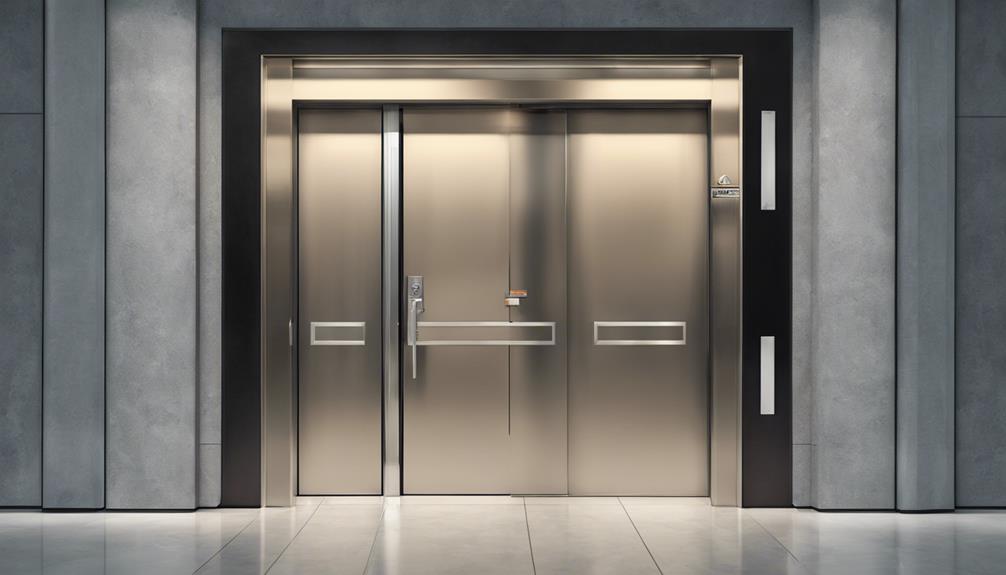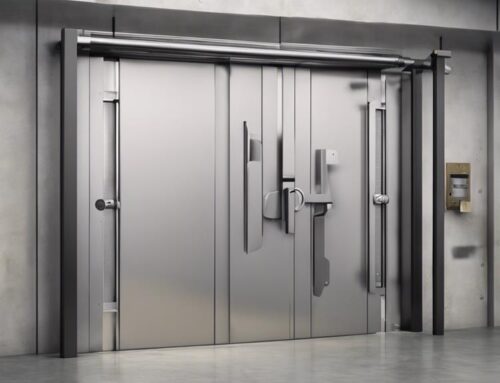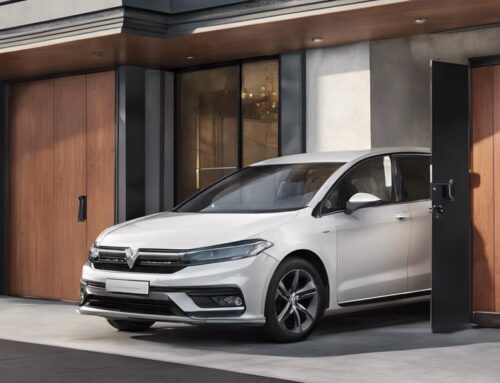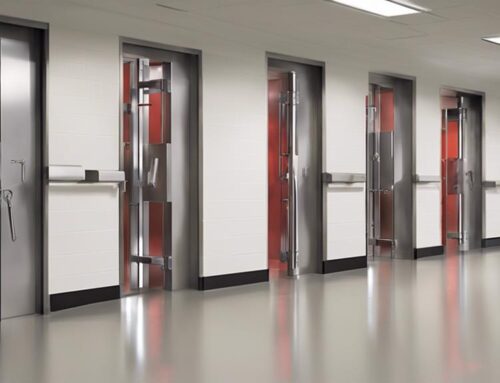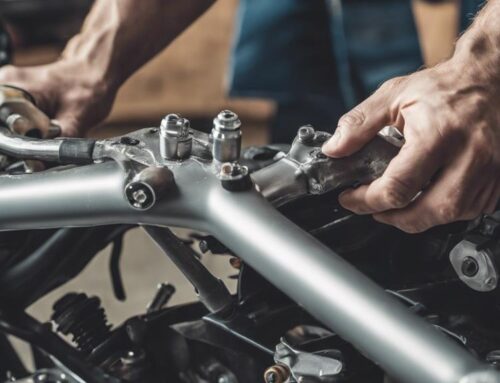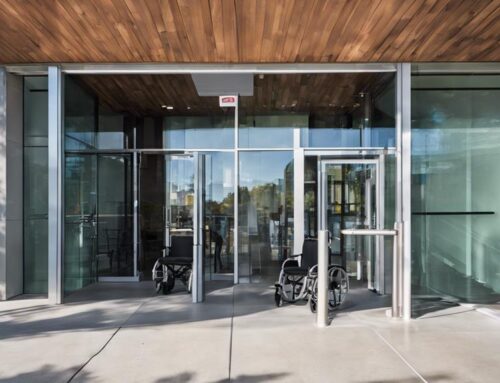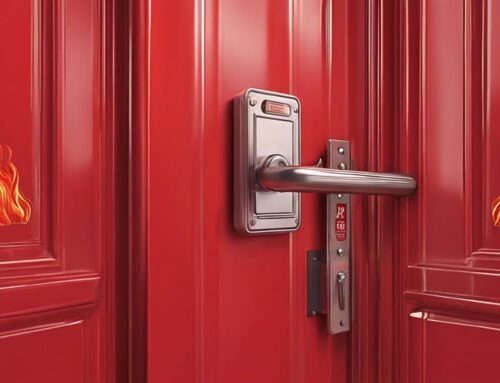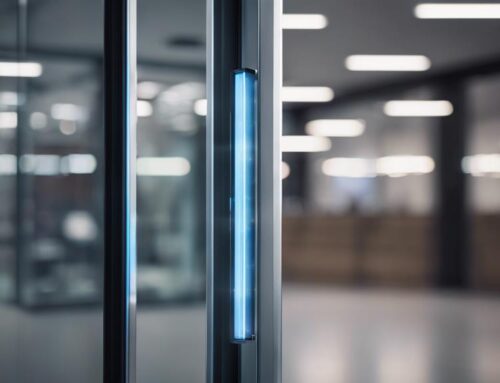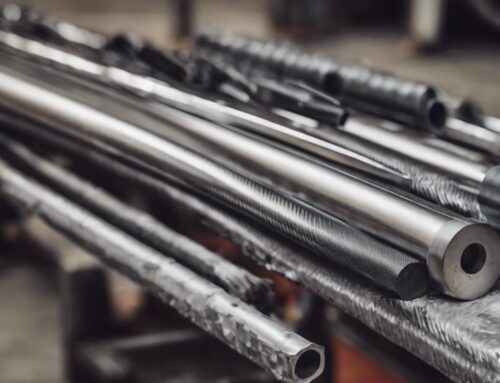You'll find that crash bars, push bars, and panic bars are vital exit devices designed for swift egress during emergencies, especially in commercial and public buildings. Crash bars offer robust durability for high-traffic areas, while push bars enable accessible, one-handed operation. Panic bars, invented in the early 1900s, have evolved with stringent safety standards and technological integrations like electronic access control. Proper compliance with building codes and fire safety regulations is essential for their functionality. The key mechanisms involve a release system that guarantees fail-safe operation for immediate exits. Explore deeper insights to understand their critical role in safety and accessibility.
Key Takeaways
- Crash bars, push bars, and panic bars enable quick egress during emergencies, critical for safety in commercial and public buildings.
- Panic bars, invented in the early 1900s, allow immediate door release with one-handed operation, crucial for emergency evacuations.
- Crash bars offer robust design for high-traffic areas, ensuring controlled access and easy exits.
- Push bars are ADA-compliant, facilitating swift exits with one-handed operation, enhancing accessibility in public spaces.
- Regular maintenance and compliance with building codes ensure the reliability and safety of these exit devices.
History of Panic Bars
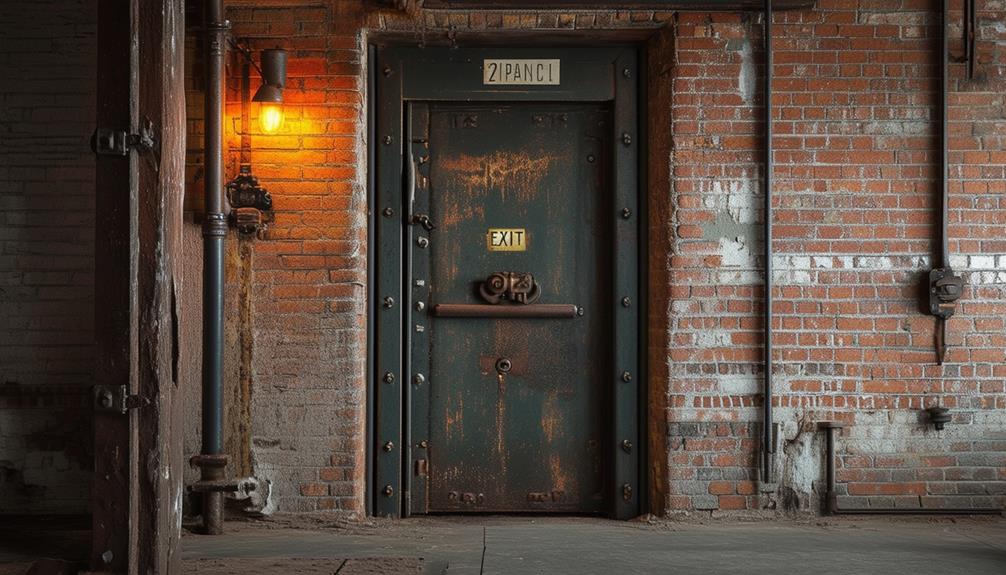
The history of panic bars is a demonstration to the evolution of building safety standards and emergency egress solutions. First invented in the early 1900s, panic hardware revolutionized how buildings manage emergency exits. These devices quickly gained traction, driven by the growing emphasis on safety regulations and building codes that demanded efficient evacuation methods. Fire code requirements have continuously shaped the development and widespread adoption of panic bars, ensuring they meet the highest safety standards.
As you trace the development of panic bars, you'll notice a continuous improvement in their design. Early iterations were basic but functional, designed to open doors with minimal force. However, as technology and material science progressed, so did panic bars. Modern designs incorporate advanced materials that enhance durability and effectiveness, ensuring that these devices remain reliable under stress.
The mid-20th century marked a significant turning point when several public safety incidents underscored the need for rapid evacuation mechanisms. Panic bars gained widespread recognition and became a standard feature in public buildings. Today, they're engineered to meet stringent safety standards, guaranteeing reliable performance during emergencies.
Understanding Crash Bar Mechanisms
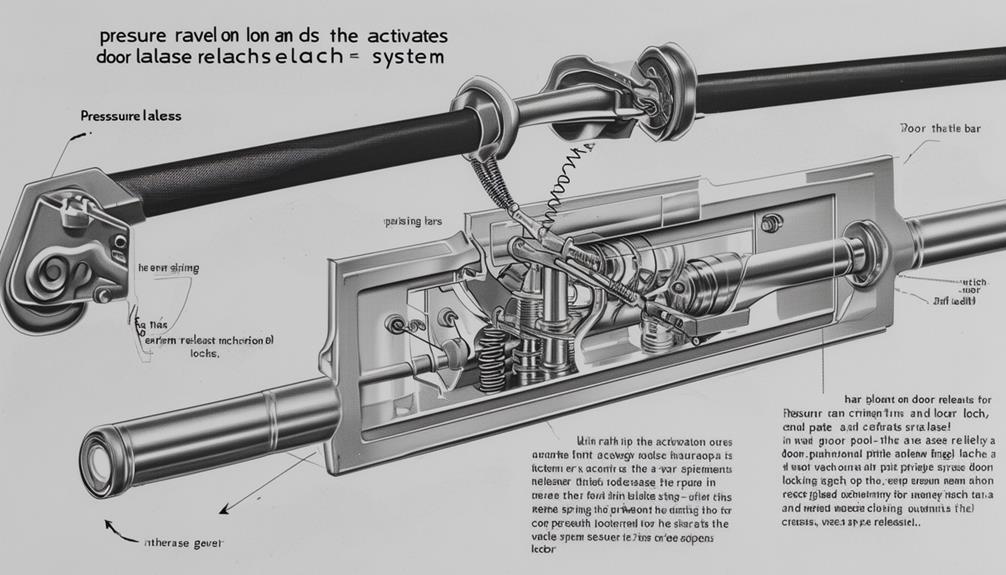
Designed to facilitate rapid and effortless egress, crash bars operate by pushing the horizontal or vertical bar, which triggers a release system and disengages the latch. This mechanism is engineered to provide swift exit without the need for keys or special tools, making it essential in high-traffic areas.
Crash bar mechanisms consist of a few key components:
| Component | Description |
|---|---|
| Horizontal/Vertical Bar | The primary interface that, when pushed, initiates the release system. |
| Release System | Activates upon pressing the bar, disengaging the latch mechanism. |
| Latch Mechanism | The component that holds the door closed until released by the system. |
| Durable Materials | Guarantees longevity and functionality under frequent use and high-impact. |
| Additional Locks | Optional integration for enhanced security while maintaining emergency egress. |
These mechanisms are meticulously constructed with high-durability materials to withstand constant use and potential high-impact collisions. Their design allows for seamless integration with additional locking mechanisms, hence balancing security and emergency accessibility. Compliance with stringent safety standards and building codes is non-negotiable, guaranteeing that crash bars function reliably in critical moments. Understanding these components and their interplay is crucial for anyone involved in the installation, maintenance, or use of crash bars, assuring they deliver the necessary performance and safety.
Applications of Push Bars
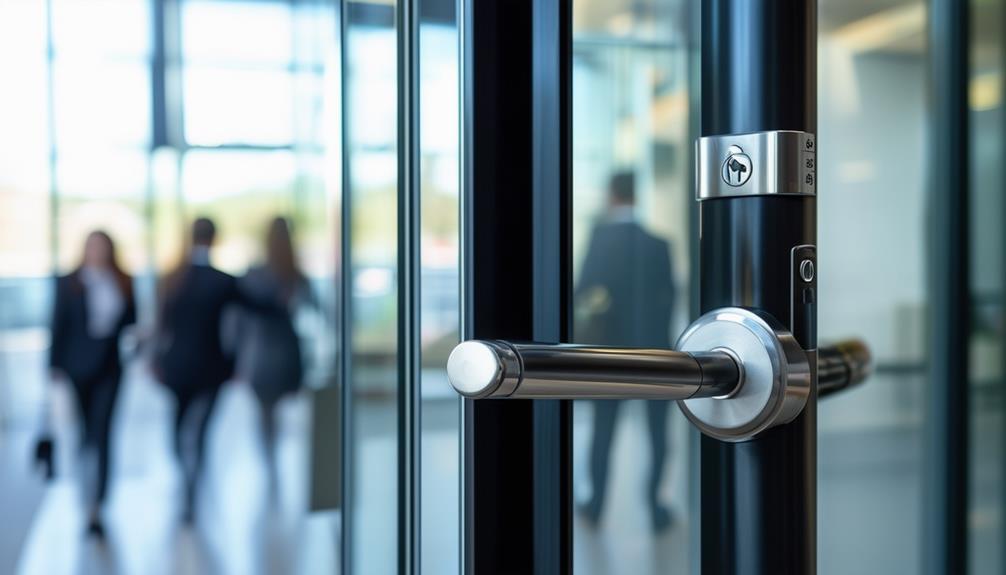
When considering the applications of push bars, especially in commercial settings, one must recognize their significant role in guaranteeing rapid and efficient emergency egress. Push bars, also known as crash bars or panic bars, are integral to high-traffic areas such as schools, hospitals, and theaters. These settings demand quick evacuation routes, making push bars indispensable for compliance with fire safety regulations and accessibility standards.
Push bars are designed for one-handed operation, allowing individuals to exit swiftly without needing keys or tools. This feature is particularly essential during emergencies when time is of the essence. The ease of operation guarantees that even individuals with disabilities can evacuate safely, adhering to stringent building codes. Regular maintenance and inspections are important for push bars to remain functional and compliant. Confirming that these devices are in ideal working condition not only enhances safety but also ensures that they meet industry standards. For facilities management, understanding the mechanics and requirements of push bars is fundamental for maintaining a secure environment. To conclude, the strategic deployment of push bars in commercial buildings is a cornerstone of emergency preparedness, providing a reliable and efficient means of egress.
Common Misconceptions
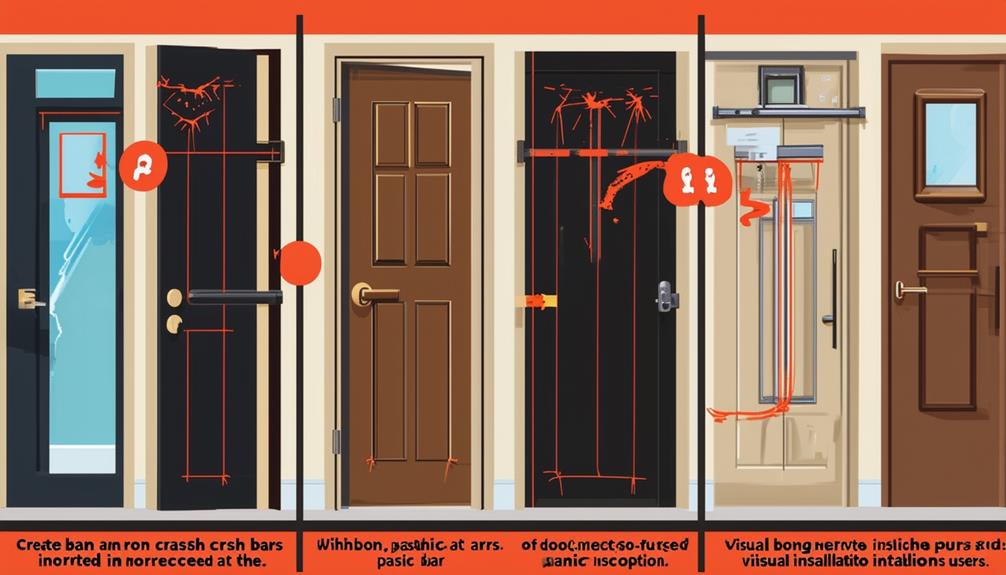
Several misconceptions surround the use of panic hardware, each potentially compromising safety protocols. One prevalent misunderstanding is the belief that all panic hardware devices, such as crash bars and push bars, serve the same purpose. In reality, crash bars are designed for high-traffic environments, allowing for swift, forceful exits, while push bars are more suited for lower-traffic areas with lighter usage. Additionally, there are various types of panic bars available, each with unique features tailored to specific applications.
Contrary to popular belief, panic bars aren't just for commercial buildings. They're increasingly found in residential settings, providing essential emergency egress. Confirming your home is equipped with proper panic hardware can greatly enhance safety during emergencies.
Another important misconception is that panic hardware requires no maintenance. Regular inspections and upkeep are critical to guarantee these devices function correctly and comply with evolving safety regulations. Ignoring maintenance can lead to malfunctions, endangering lives during an emergency.
Here are three fundamental points to dispel these misconceptions:
- Crash bar vs. push bar: Understand their distinct functionalities for different environments.
- Residential applications: Recognize their growing importance in homes.
- Maintenance needs: Commit to regular inspections and compliance with safety standards.
Understanding these nuances guarantees you make informed decisions about panic hardware, thereby enhancing overall safety.
Evolution of Panic Bar Design
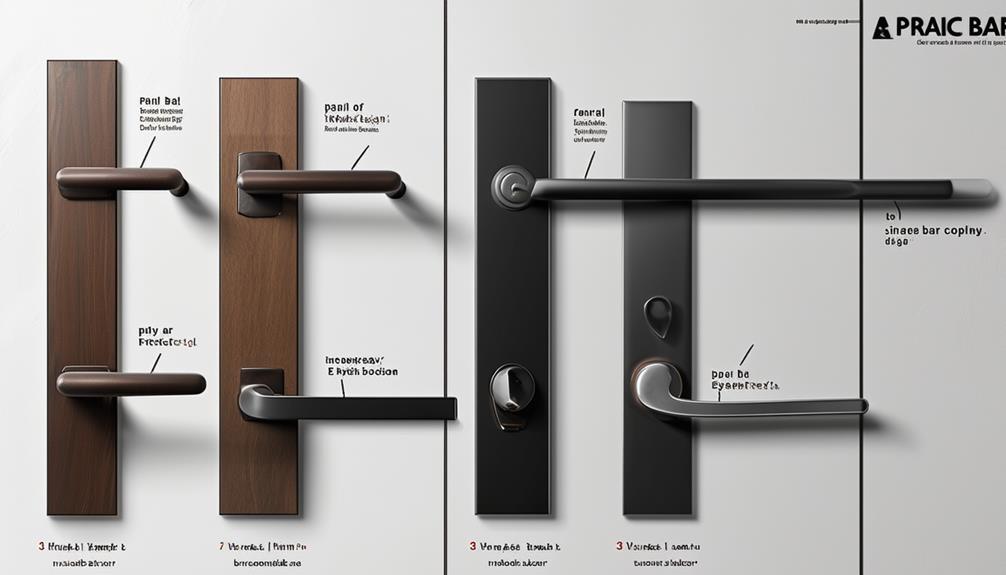
The evolution of panic bar design has been marked by significant advancements, transforming these devices from rudimentary mechanical tools into sophisticated safety systems. Early panic bars, introduced in the early 1900s, were mainly constructed from heavy metal, focusing solely on mechanical egress. Today's designs employ lighter, stronger materials, enhancing both durability and functionality.
Technological advancements have revolutionized panic bars, enabling seamless integration with electronic access control systems. This integration facilitates heightened security and real-time monitoring, guaranteeing compliance with modern safety standards. In addition, the introduction of aesthetic designs allows panic bars to blend seamlessly with various architectural styles without compromising their primary safety functions.
Regulatory requirements and evolving safety standards have played a vital role in shaping panic bar design. Compliance with building codes and accessibility guidelines guarantees that these devices not only meet but often exceed safety expectations, providing reliable egress solutions in critical scenarios.
| Era | Material Used | Key Features |
|---|---|---|
| Early 1900s | Heavy Metal | Basic Mechanical Egress |
| Modern Designs | Lighter, Stronger | Durability, Enhanced Functionality |
| Present Day | Advanced Materials | Electronic Integration, Aesthetic Design |
Global Usage of Panic Bars
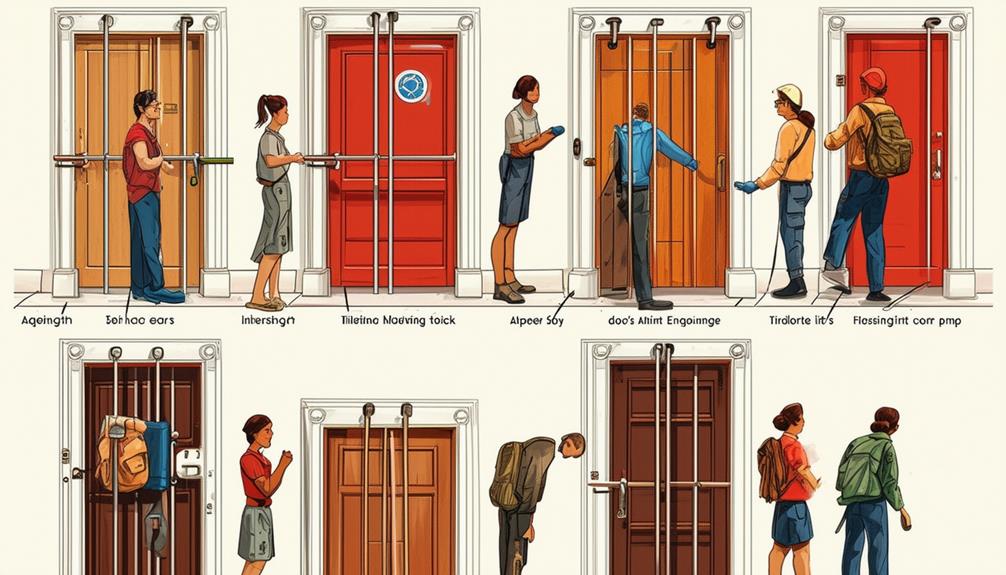
Ever wonder why panic bars are a staple in buildings around the world? These crash bars are not just a convenience; they're mandated by various building codes globally to guarantee safe egress in emergencies. You'll find them installed in high-traffic areas like schools, hospitals, theaters, and stadiums, where rapid evacuation is imperative. Panic bars also play a key role in fire code safety, by being rigorously tested and certified to meet safety and functionality standards.
Here's why panic bars are indispensable:
- Compliance with Regulations: Many countries have stringent fire safety regulations requiring panic hardware. These rules enhance public safety by guaranteeing that exits are accessible and functional during emergencies.
- Inclusive Design: Modern crash bars incorporate accessibility features, guaranteeing that individuals with disabilities can also use these emergency exits. This inclusivity is essential for thorough safety planning.
- Maintenance and Inspections: Regular inspections and maintenance of panic bars are fundamental for compliance with international safety standards. This guarantees that they remain operational and reliable when needed most.
Safety Benefits
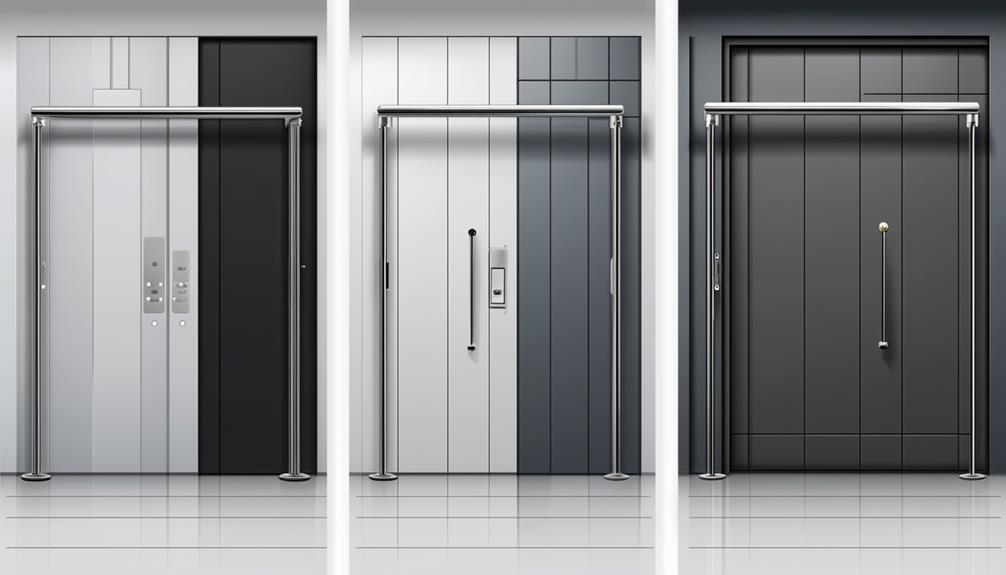
When it comes to guaranteeing safety in emergency situations, crash bars and panic bars stand out as essential components of modern building design. These safety bars are engineered to provide immediate egress, allowing users to exit quickly without fumbling for keys or handles. This feature is critical during emergencies when every second counts.
Panic hardware, including crash and push bars, is designed for one-handed operation, making certain that even individuals with disabilities can exit safely and efficiently. The fail-safe design of these safety bars guarantees that doors remain operable during emergencies, greatly reducing the risk of injury or entrapment. For businesses looking for affordable emergency exit solutions, options like these are both effective and economically viable.
Compliance with building codes and fire safety regulations is another essential benefit of installing crash bars and panic bars. These devices guarantee that exit routes in commercial and public buildings remain unobstructed, which is a legal mandate. Regular maintenance and adherence to safety standards are fundamental for the reliability of panic hardware. Proper upkeep guarantees these devices perform reliably in high-stress situations, maintaining safety and compliance.
Comparison with Other Exit Devices
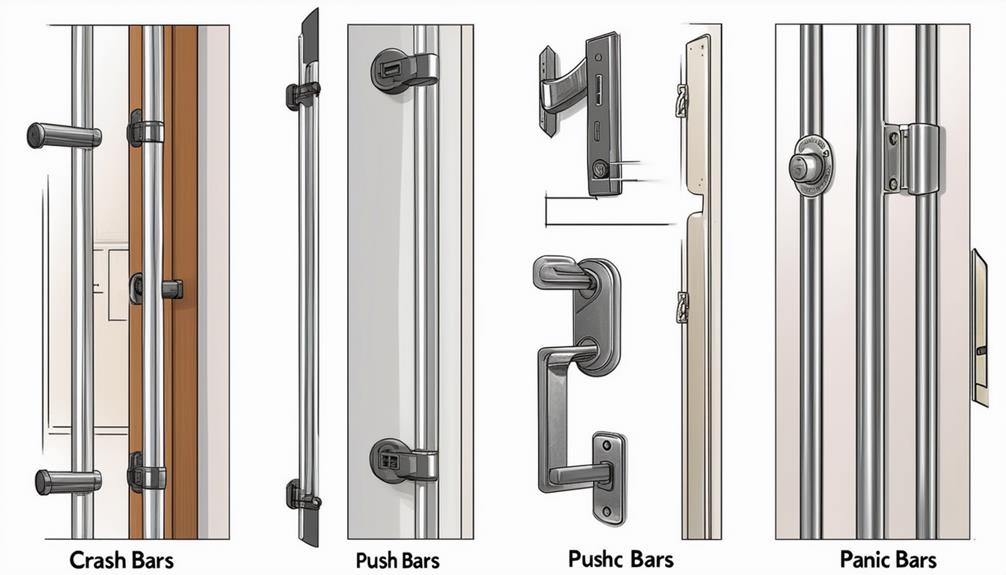
Many building safety systems incorporate various exit devices, each designed to serve specific needs and environments. When comparing crash bars and panic bars to other exit devices, you'll notice several key differences that impact their functionality and suitability.
- Design and Operation: Crash bars are ideal for high-traffic areas due to their robust design, allowing activation by pushing vertically or at an angle. Conversely, panic bars feature a horizontal push mechanism, enabling one-handed operation for rapid egress, particularly during emergencies. Panic bars comply with fire safety regulations, guaranteeing unblocked exits and reducing the risk of injury during emergencies.
- Installation Requirements: Panic bar installation often necessitates professional setup to meet stringent safety standards. In contrast, crash bar installation can be more straightforward, though it still requires alignment with specific application needs and compliance with building codes. Technicians specializing in panic bar installation utilize high-quality materials for both installation and replacement, guaranteeing long-lasting results.
- Safety Compliance: Both crash bars and panic bars are designed to meet fire safety regulations and building codes, guaranteeing secure egress routes in commercial and public spaces. However, panic bars may include additional safety features, such as alarms, to enhance emergency readiness.
Understanding these distinctions guarantees you select the appropriate exit device for your building's requirements, balancing ease of installation with the necessity for reliable emergency egress solutions.
Legal Definitions

Understanding the legal definitions of crash bars, push bars, and panic bars is vital when selecting the right exit device for your building. These devices, essential for emergency egress, must comply with stringent building codes and safety regulations. Panic hardware, for example, is legally defined as a mechanism that allows doors to be opened swiftly without the need for keys or tools, guaranteeing occupants can evacuate safely during emergencies. Additionally, it's important to take into account professional and affordable installation of commercial exit devices to meet all safety standards.
Building codes often mandate the use of panic bars in commercial settings to enhance safety and accessibility. The legal definitions of these devices emphasize one-handed operation and fail-safe functionality, assuring that even in chaotic situations, exit points remain operable. Additionally, these devices must meet specific testing standards, such as ANSI/BHMA certifications, to comply with fire safety regulations.
While the legal definitions may vary by region, the core principles remain consistent: quick, reliable egress and adherence to safety standards. By understanding these legal definitions, you can guarantee your building's exit devices not only meet regulatory requirements but also provide the highest level of safety for all occupants. Always consult local building codes to confirm compliance with regional legal definitions and standards.
Future Trends
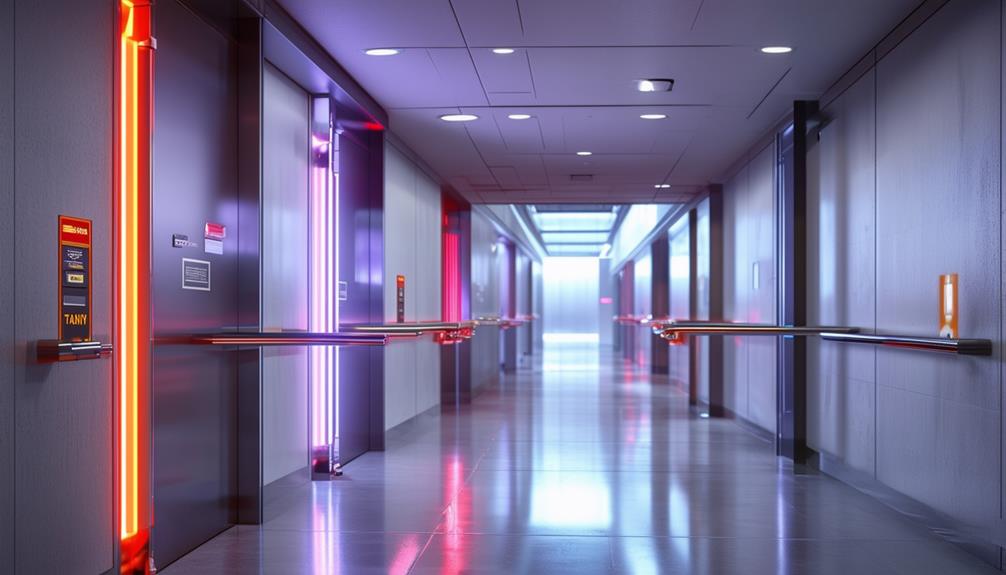
Amid a rapidly evolving landscape of building safety and technology, the future trends in crash bars, push bars, and panic bars are poised to revolutionize emergency egress systems. You'll see a significant rise in the integration of smart technology within emergency exit bars, incorporating features like electronic access control and remote monitoring. According to an exploration of electronic panic bars, these advancements will not only enhance security but also streamline maintenance through real-time alerts and diagnostics.
Sustainability is another key trend. Manufacturers are increasingly using eco-friendly materials and sustainable production methods. This shift aligns with global efforts to minimize environmental impact while maintaining the robustness and reliability of emergency exit bars.
Furthermore, innovations in design are making these devices more aesthetically pleasing, ensuring they blend seamlessly with modern architectural styles without compromising safety standards. This is particularly important in high-traffic environments where both form and function are critical.
Here's what to look for in the future of emergency exit bars:
- Smart Technology Integration: Enhanced electronic access control and remote monitoring capabilities.
- Sustainable Materials: Increased use of eco-friendly materials and production practices.
- Aesthetic Innovations: Designs that complement modern architecture while ensuring safety compliance.
These trends reflect a thorough approach to improving both the functionality and visual appeal of emergency exit systems.
How Low Rate Locksmith Enhances Security with Crash, Push, and Panic Bars
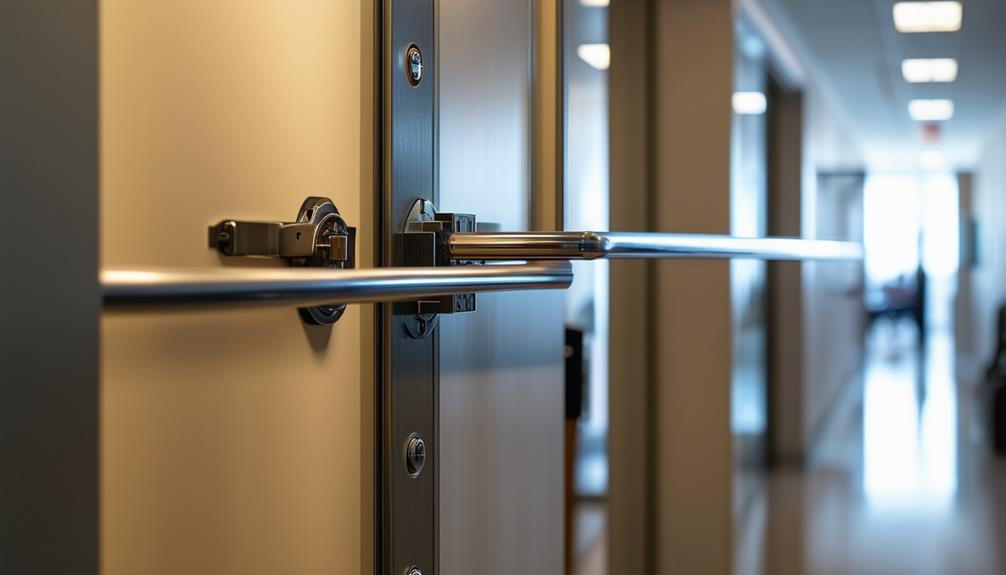
Proper installation of crash bars, push bars, and panic bars by Low Rate Locksmith enhances security in commercial and public buildings. These exit devices are vital for guaranteeing safe and quick egress during emergencies, aligning with building codes and fire safety regulations. By selecting the appropriate hardware, Low Rate Locksmith provides solutions that meet ADA standards and user accessibility needs.
| Requirement | Solution Provided by Low Rate Locksmith |
|---|---|
| Emergency Egress | Installation of panic bars for quick exits |
| Compliance with Regulations | Guarantees adherence to building codes and fire safety standards |
| Routine Maintenance | Regular inspections to prevent malfunctions |
| User Accessibility | ADA-compliant push bars tailored to specific needs |
| Controlled Access | Crash bars integrated for security and swift exits |
Low Rate Locksmith's expertise guarantees that these devices not only function correctly but also enhance the overall security of your property. Regular maintenance and inspections prevent potential malfunctions, providing peace of mind. Additionally, integrating crash and push bars can greatly improve security by allowing controlled access while facilitating swift emergency exits.
Frequently Asked Questions
What Is the Difference Between a Panic Bar and a Crash Bar?
The main difference between a panic bar and a crash bar lies in their purpose and design. Panic bars are engineered for emergency exits, enabling quick egress without keys, often required by building codes. They feature a horizontal push mechanism for automatic latch release. Crash bars, used in high-traffic areas, offer both horizontal and vertical push options, focusing on durability and ease of access. They're more affordable and simpler to install.
What Is the Difference Between a Panic Bar and a Push Pad?
Imagine pressing a lifeline in an emergency. A panic bar, with its horizontal bar, releases the latch instantly, ensuring swift egress and compliance with safety codes. In contrast, a push pad spans the door's width, requiring more force and suited for low-traffic areas. Both allow one-handed operation, but panic bars cater to high-traffic, emergency exits, while push pads fit specific, less urgent applications.
What Is the Point of a Crash Bar?
A crash bar's purpose is to facilitate swift emergency egress by allowing doors to be opened with a simple push. You'll find these devices essential in high-traffic areas, ensuring reliable operation under repeated use and high impact. Installed on the interior side of doors, crash bars provide hands-free exit, enhancing safety without requiring keys or tools. They comply with fire safety regulations, offering secure yet accessible evacuation routes.
What Is the Purpose of a Panic Bar?
A panic bar's purpose is to facilitate rapid egress during emergencies, ensuring compliance with building codes and fire safety regulations. You'll find it's designed for one-handed operation, allowing quick exits even for those with disabilities. High-impact durability makes it ideal for high-traffic areas, and adherence to ANSI/BHMA standards guarantees reliability. By pushing the bar, you release the door, enabling immediate escape without needing keys or tools.
Conclusion
Coincidentally, just as fire safety measures evolved, so did the technology behind crash bars, push bars, and panic bars. Leveraging modern advancements, Low Rate Locksmith guarantees top-tier security by integrating these devices seamlessly. With a detailed understanding of their mechanisms and applications, you're equipped to make informed decisions. Don't let common misconceptions cloud your judgment—embrace these critical exit devices for enhanced safety. Stay ahead of future trends and legal standards by trusting experts who prioritize precision and reliability.

